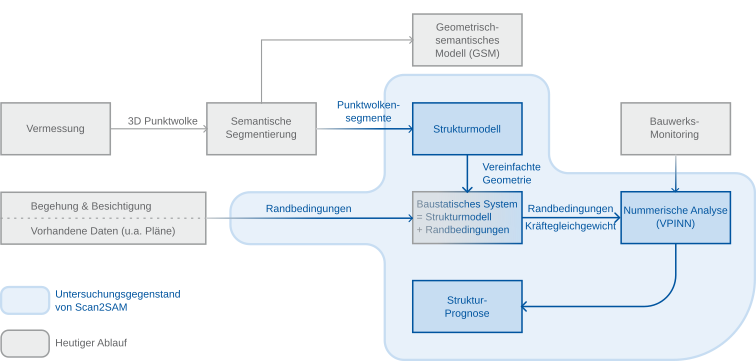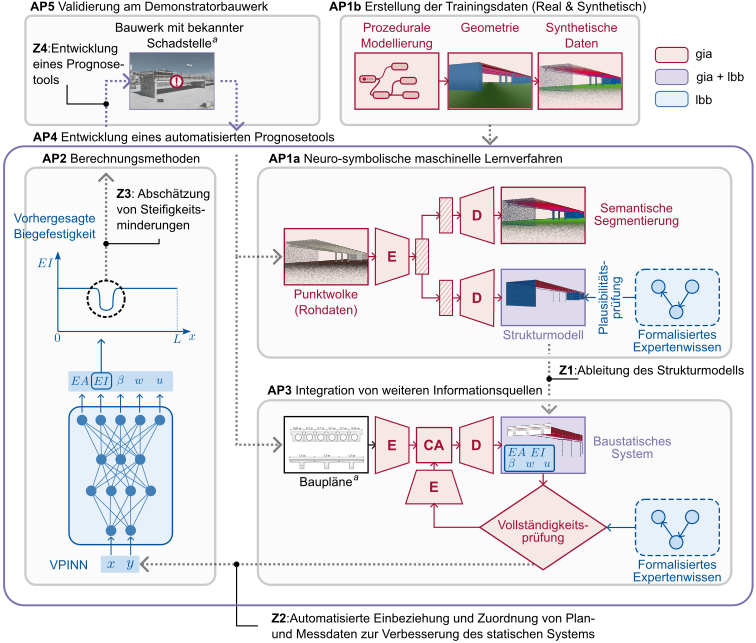Scan2SAM - Data-driven generation of structural analysis systems based on 3D point clouds and formalized knowledge for VPINN-based condition prediction
Digital twins represent physical objects from the real world in a virtual environment, tailored to specific use cases. A key requirement for a comprehensive digital representation is the ability to combine various properties of the physical object, including geometric, functional, and physical aspects. To achieve this, the real object is described using different digital models. These include geometric-semantic models (GSM) for visualization and data referencing, as well as abstracted structural models for structural analysis. In practice, however, these models are developed using different methods. Since they are created separately and independently, integrating them into a digital twin is difficult. As a result, the models often coexist without strong coupling, which complicates later interaction between them.
This is where the Scan2SAM project comes in. The goal is to investigate the methodological foundations for developing a prediction tool. This tool will automatically generate a structural model and, in a second step, a structural analysis system by enriching the model with boundary conditions, using semantically segmented 3D point clouds as input. The resulting system can then be used for numerical analysis of the structure. Based on this system and SHM data, the stiffness distribution will be predicted using Variational Physics-Informed Neural Networks (VPINNs). This prediction can then be used to identify damaged areas within the structure (see Fig. 1)

Specifically, Scan2SAM pursues the following objectives:
O1: Derive a structural model from semantically segmented 3D point clouds for the structural assessment of existing structures.
O2: Automate the integration and assignment of design and measurement data to generate and refine the structural analysis system with respect to boundary and interface conditions, as well as to estimate stiffness values within the structural model.
O3: Develop a VPINN based calculation method capable of estimating effective stiffness based on measurement data and predicting the location of stiffness reductions to enable conclusions regarding the extent and location of damage.
O4: Develop a prediction tool that, based on O1 to O3, can automatically derive the structural analysis system, estimate key properties, determine actual structural properties using measurement data, and quantify and localize potential damage.

Team
Publications
[1] Vassilev, H., Laska, M., & Blankenbach, J. (2024). Uncertainty-aware point cloud segmentation for infrastructure projects using Bayesian deep learning. Automation in Construction, 164, 105419. https://doi.org/10.1016/j.autcon.2024.105419
[2] Kellner, M., Vassilev, H., Busch, A., Blaskow, R., Ferrandon Cervantes, M., Poku-Agyemang, K. N., Schmitt, A., Weisbrich, S., Maas, H.-G., Neitzel, F., Reiterer, A., & Blankenbach, J. (2024). Scan2BIM – A Review on the Automated Creation of Semantic-Aware Geometric as-is Models of Bridges. Avn – Allgemeine Vermessungs-Nachrichten, 3, 159–181. https://doi.org/10.14627/avn.2024.3.4
[3] Mansour, M., Martens, J., & Blankenbach, J. (2024). Hierarchical SVM for Semantic Segmentation of 3D Point Clouds for Infrastructure Scenes. Infrastructures, 9(5), 83. doi.org/10.3390/infrastructures9050083
[4] Vassilev,H. Blankenbach J. (2025), Empirischer Vergleich von Deep-Learning-Ansätzen zur semantischen Segmentierung von 3D-Punktwolken auf realen Brückendatensätzen. Avn - Allgemeine Vermessungs-Nachrichten. (under review)






